Learn the stories of Bible's pivotal characters, from Adam to Zechariah, and uncover the lesser-known figures shaping faith's tapestry.
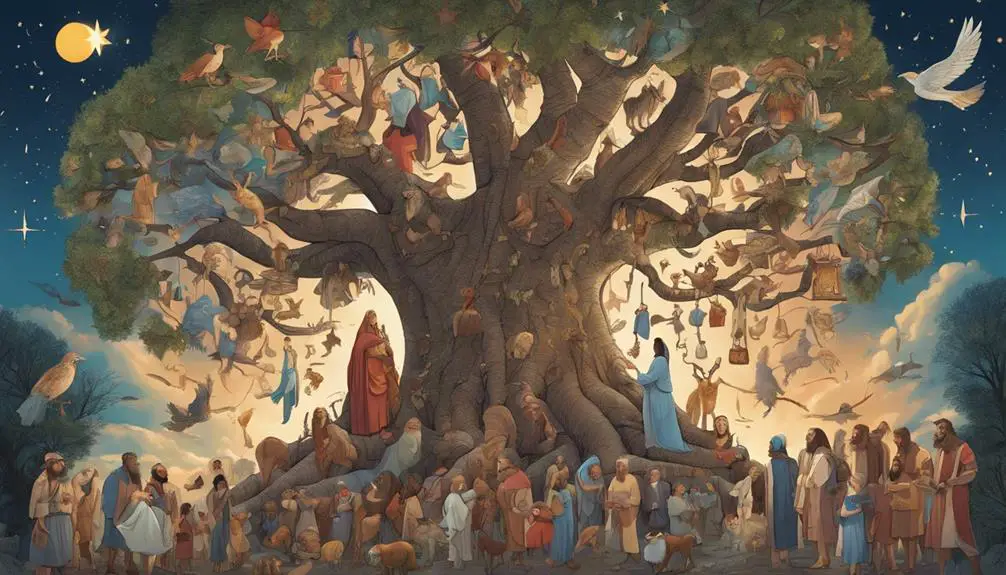
Whos Who in the Bible
Navigating the Bible without understanding its key figures is like trying to find your way through a city without a map. You're here because you recognize the importance of knowing not just the landmarks — the Patriarchs, Kings, Prophets, and Apostles — but also the hidden gems: the Heroines and unsung heroes whose stories provide depth and context to the more famous narratives.
By exploring these characters, you're embarking on a journey that will take you beyond the surface, offering insights that connect ancient texts to the complexities of modern life. What awaits is a richer understanding, but where will you start?
Key Takeaways
- The Bible features foundational figures like Abraham and Moses, who set precedents for faith and covenant relationships.
- Kings and prophets like David and Elijah play pivotal roles, offering lessons on leadership and obedience.
- Inspirational women such as Esther and Ruth highlight courage and loyalty, emphasizing the importance of female figures.
- Early Christianity was shaped by leaders like Paul and Peter, who emphasized inclusivity, ethical living, and faith.
The Patriarchs of Genesis
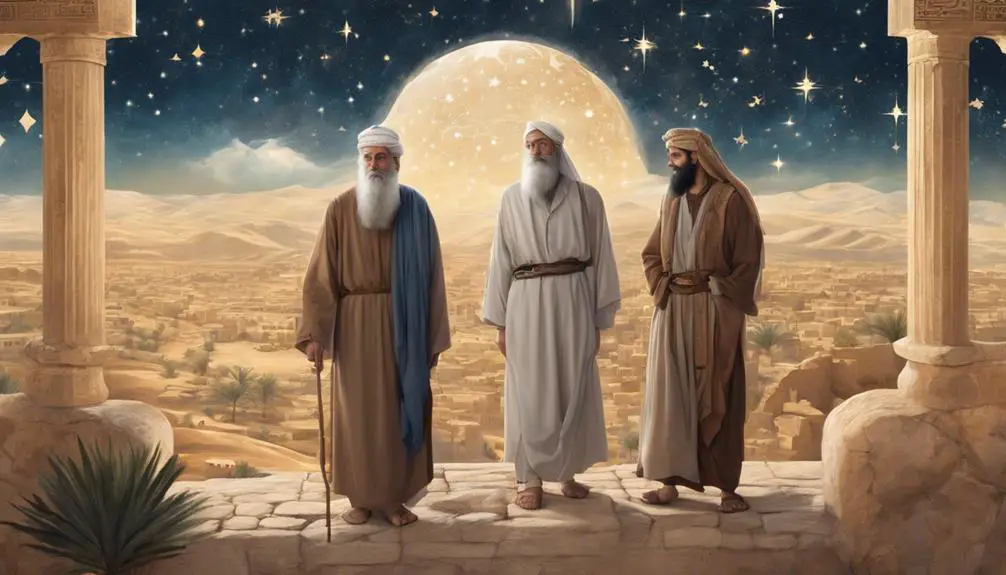
In the book of Genesis, the Patriarchs stand as foundational figures shaping the early narrative of the Hebrew Bible. You'll notice their stories aren't only central to understanding the origins of the Israelite people but also crucial for grasping the concept of covenant relationships in biblical theology. The Patriarchal narratives focus on Abraham, Isaac, Jacob, and Joseph, each representing a successive link in the chain of God's promises to His chosen people.
Patriarchal lifespans in these stories are notably extended, with Abraham living to 175 years, Isaac to 180, and Jacob to 147. These lengthy lifespans aren't just historical curiosities; they underscore the Patriarchs' elevated status and their close proximity to the divine. The extended years are often seen as a mark of God's favor, highlighting the significance of these individuals in the divine plan.
The covenant significance within these narratives can't be overstated. Abraham's covenant with God, for instance, establishes a foundational relationship not only for him but for his descendants, promising them land, progeny, and a unique relationship with the divine. This covenant is renewed with Isaac and Jacob, reinforcing the idea that the Patriarchs aren't just historical figures but are crucial in the theological and covenantal framework of the Bible. Their lives and relationships with God exemplify faith, obedience, and the complexities of human-divine interaction, setting the stage for the themes that will continue to develop throughout the biblical text.
Kings and Prophets of Israel
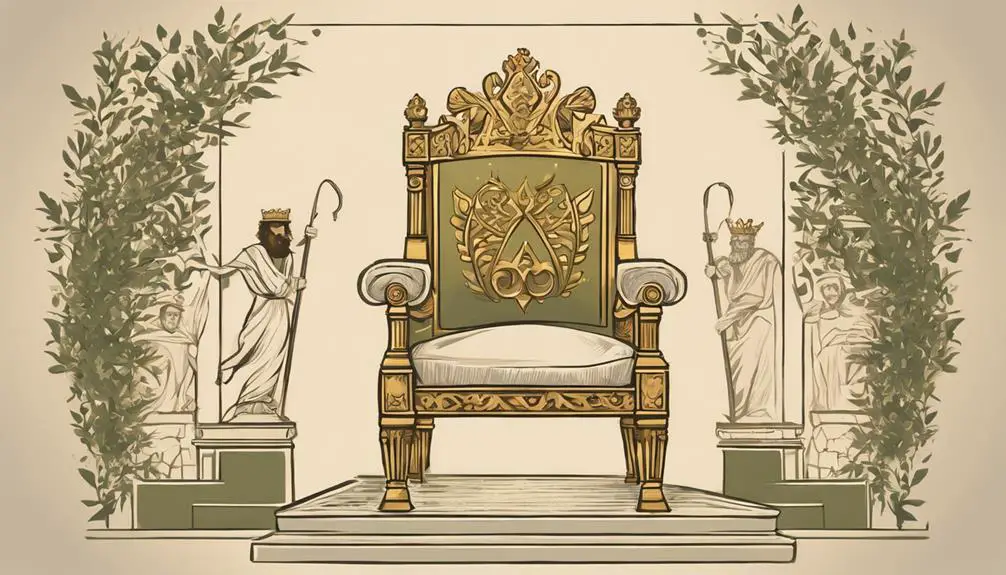
Following the era of the Patriarchs, the narrative of the Hebrew Bible shifts to spotlight the complex roles of kings and prophets in Israel, instrumental in shaping its history and religious identity. You'll find that the kings, beginning with Saul, David, and Solomon, not only governed but also played pivotal roles in the spiritual and political evolution of Israel. Saul's downfall, for example, is a compelling story of how personal flaws and disobedience to divine commands led to the loss of his kingdom, highlighting the Bible's theme of divine retribution and the importance of faithfulness.
On the other hand, the prophets, like Elijah, served as the moral compass of the nation, often challenging the kings' authority and guiding the people back to the covenant with God. Elijah's miracles, including raising the dead and calling down fire from heaven, underscore his divine authority and the power of faith in the face of adversity. These stories aren't just historical accounts but serve as moral and spiritual lessons on leadership, obedience, and faith.
The interplay between kings and prophets in Israel is a dynamic narrative of power, prophecy, and piety. It underscores the belief in a divine plan and the consequences of human action, both good and bad. As you delve deeper, you'll appreciate how these figures, with their virtues and vices, shaped the course of Israel's history and left an indelible mark on its religious identity.
Heroines of the Old Testament

Shifting focus from the kings and prophets, the heroines of the Old Testament emerge as pivotal figures, embodying strength, wisdom, and faith in their narratives. Against the backdrop of a time when women's leadership was often overlooked, these figures stand out, showcasing resilience and resourcefulness within their cultural context. Their stories offer profound insights into the roles and perceptions of women in ancient societies, highlighting the complexities of navigating leadership and faith.
- Esther: Her story is a powerful example of courage and tactical wisdom. Esther, becoming queen in a foreign land, uses her position to save her people from genocide. Her leadership is marked by strategic patience and bravery, demonstrating the significant impact of women's leadership in a critical moment of history.
- Deborah: As a prophetess and a judge, Deborah's role is unique in the biblical narrative. She leads Israel to victory in a time of oppression, embodying both spiritual and military leadership. Her story underscores the acceptance of women's leadership in various roles, challenging traditional gender roles within her cultural context.
- Ruth: Ruth's loyalty and determination shine through her story of tragedy and redemption. Her decision to stay with her mother-in-law Naomi and her subsequent actions lead not only to her personal redemption but also to her becoming an ancestor of King David. Ruth's narrative highlights the importance of loyalty, family, and faith, providing a nuanced perspective on personal strength and commitment.
These heroines, among others in the Old Testament, provide valuable lessons on leadership, faith, and resilience, resonating well beyond their historical and cultural context.
Jesus and His Disciples
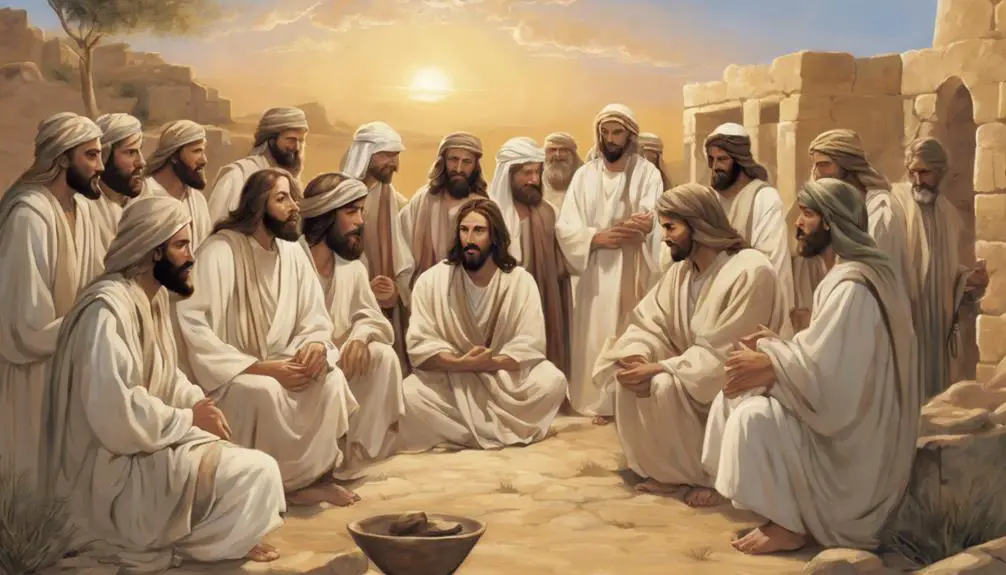
Jesus's selection of His disciples marks a foundational moment, illustrating the diverse backgrounds and personalities chosen to spread His teachings across the world. These twelve individuals, ranging from fishermen to a tax collector, embodied a variety of societal roles, highlighting Jesus's message of inclusivity and universal salvation. Their calling wasn't just a personal transformation but a strategic move to ensure the message of love, forgiveness, and redemption reached every corner of society.
You'll find the narrative of these disciples interwoven with miraculous healings and parable teachings, elements that underscored the radical nature of Jesus's message. The miraculous healings weren't just acts of compassion but powerful demonstrations of Jesus's authority over physical and spiritual ailments, reinforcing His teachings and the disciples' faith. Meanwhile, the parable teachings served as a critical tool for the disciples, providing them with profound insights into the kingdom of heaven in a relatable manner, which they'd later use to teach and spread the Gospel.
The journey of the disciples, from their initial call to their pivotal role in the early Church, showcases a remarkable evolution. Initially, they grappled with understanding Jesus's teachings and mission, often depicted in the Gospels as questioning or doubting. However, their transformation post-resurrection and during Pentecost reveals a profound deepening of faith and understanding, equipping them to carry forward Jesus's mission with zeal and courage.
In analyzing Jesus and His disciples, you're not just examining historical figures but exploring a dynamic blueprint for spreading transformative teachings. Their story is a testament to the power of faith, diversity, and dedication in impacting the world.
Key Figures in the Acts and Epistles
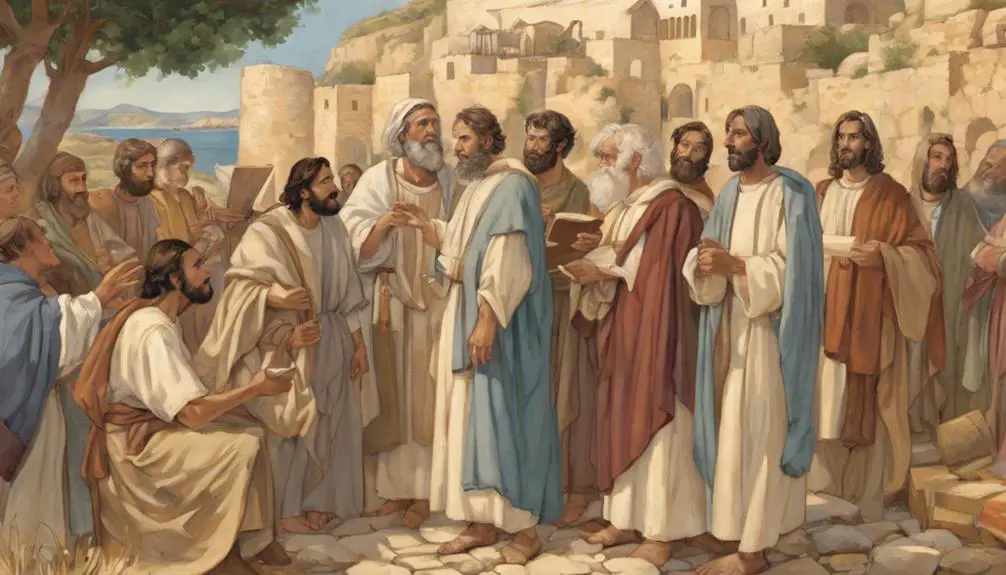
Building on the foundation laid by Jesus and His disciples, the Acts and Epistles introduce us to pivotal figures whose contributions significantly shaped the early Christian church. These individuals played critical roles in spreading the message of Christianity, navigating its early challenges, and laying down theological frameworks that continue to influence Christian thought today.
- Paul: Formerly known as Saul of Tarsus, Paul's transformation from a persecutor of Christians to a central figure in early Christianity is nothing short of remarkable. His missionary journeys across the Roman Empire, detailed in the Acts of the Apostles, were instrumental in spreading Christianity beyond its Jewish roots. Paul's epistles, addressing various early Christian communities, tackle doctrinal issues, ethical living, and the significance of Jesus' death and resurrection. His advocacy for Gentile inclusion without the need for conversion to Judaism fundamentally altered the trajectory of Christian development.
- Peter: Recognized as one of Jesus' closest followers, Peter emerges as a leading figure in the early church, especially among Jewish Christians. His vision, as recounted in Acts, leads him to understand and champion the inclusion of Gentiles into the Christian community. Peter's letters stress the importance of steadfast faith amidst persecution and the role of Christians as a 'holy nation.'
- James: Often identified as the brother of Jesus, James played a pivotal role in the Jerusalem church. He's best known for his emphasis on practical Christian living and the importance of faith expressed through good works. His leadership during the Council of Jerusalem was crucial in addressing the issue of Gentile inclusion, balancing the church's Jewish heritage with its expanding Gentile mission.
These figures, among others, were instrumental in navigating the early church through complex theological, social, and cultural shifts, laying a foundation that would allow Christianity to grow into a global faith.
Frequently Asked Questions
How Do Non-Canonical Texts and the Apocrypha Influence Our Understanding of Lesser-Known Biblical Figures?
Non-canonical texts, like the Gnostic Gospels, and the apocrypha offer you deeper insights into lesser-known biblical figures. Through textual criticism, you can analyze these texts to understand their historical contexts and theological perspectives.
This approach helps you see how these figures were viewed outside the canonical Bible, enriching your understanding of their roles and significance. It's a way to explore the nuances of biblical stories and characters beyond the traditional narrative.
What Roles Do Animals and Natural Elements Play in Biblical Narratives, and Are There Specific Symbolic Meanings Attached to Them?
In the tapestry of biblical narratives, animals and natural elements aren't just background actors; they're pivotal characters. Animal metaphors and creation stories weave through texts, each element and creature carrying deep symbolic meanings.
You'll find that these symbols enrich the stories, offering layers of interpretation and insight. Analyzing them, you uncover how they shape moral, spiritual, and cultural landscapes, revealing a profound connection between mankind and the natural world around us.
How Have Archaeological Discoveries in Recent Years Altered or Confirmed the Historical Context of Various Biblical Characters Not Covered in the Main Sections?
Recent archaeological discoveries have both altered and confirmed the historical context of various biblical characters. Radiocarbon dating limitations and inscription authenticity debates often challenge the accuracy of these findings.
However, when data aligns, it offers compelling evidence that supports or refines our understanding of biblical narratives. You'll find that these discoveries provide a deeper insight into the historical backdrop, enhancing your comprehension of the events and figures within the biblical texts.
In What Ways Do Cultural and Historical Contexts Outside of Israel and Early Christianity Impact the Interpretation of Certain Biblical Figures' Actions and Significance?
Peeling back the layers of time, you'll find modern interpretations of biblical figures deeply influenced by cultural and historical contexts beyond Israel and early Christianity. These contexts color the characters' actions and significance, offering fresh ethical perspectives.
Your understanding of these figures is enriched when analyzing them through the lens of diverse civilizations. This analytical approach allows you to appreciate the complexity and multifaceted nature of their stories and roles.
Can the Depiction of Angels and Demons in the Bible Provide Insight Into the Spiritual and Moral Framework of Biblical Times Beyond the Main Characters Mentioned?
Absolutely, the depiction of angels and demons in the Bible can give you deeper insight into the spiritual and moral landscape of those times. Understanding the angel hierarchy and demon origins isn't just about the supernatural; it's a window into the values, fears, and aspirations of ancient societies.
It shows how they conceptualized good and evil, authority, and rebellion, offering a nuanced view beyond the actions of the main characters.
Conclusion
As you've journeyed through the tapestry of the Bible, from the foundational pillars of the Patriarchs in Genesis to the transformative messages of the Apostles, it's clear that each character is a thread intricately woven into the grand narrative of faith and redemption.
Like stars in the night sky, each figure shines with a unique light, guiding humanity through the ages.
This celestial map not only charts a historical path but also illuminates the enduring power of belief and the profound impact of divine intervention on human history.


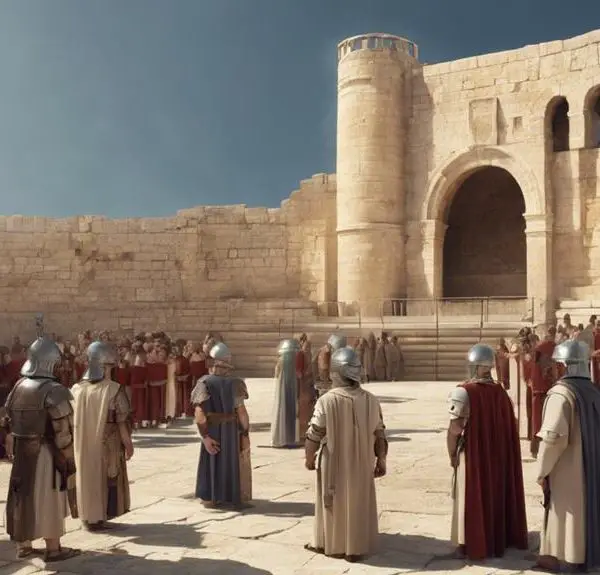
Sign up